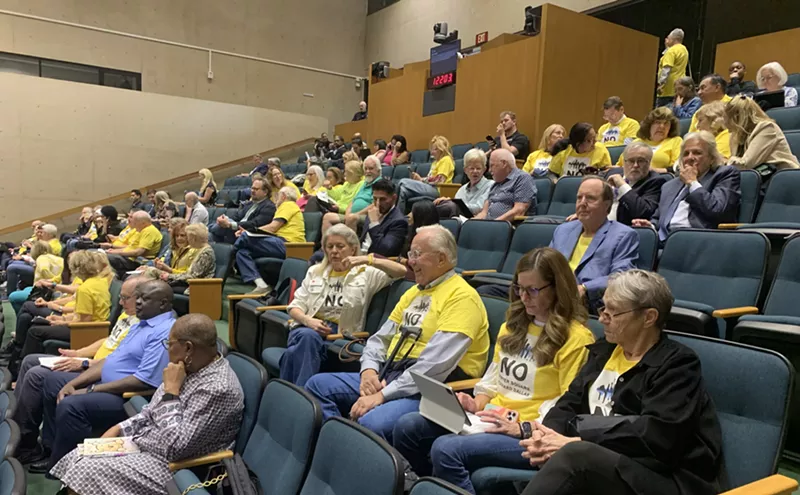Indeed, by historical standards, Dallas residents did a remarkable job in 2015 of not killing, maiming, stealing from or otherwise victimizing one another. The citizenry's newfound restraint, however, is only part of the story behind Dallas' plummeting crime rate, which also has a lot to do with national trends, sky-high benchmark crime rates, and the artful manipulation of crime statistics. Put another way, while Dallas is undeniably safer today than it was in, say, the '80s and '90s, there are plenty of reasons to cast a wary eye on Brown's victory lap.
Violent Crime is Up
Having a home or car burglarized or having a cell phone stolen sucks, but property crimes typically don't make the TV news or conjure visions in the minds of Plano housewives of downtown Dallas as a latter-day Gomorrah. The crimes that make people terrified to walk down the street are crimes of violence: robberies, aggravated assaults, rapes, murders. In his public celebrations of the 2015 crime stats, Brown has pointedly avoided mentioning that violent crime is actually up for the second consecutive year. After hitting a nadir in 2013 with 8,330 violent crimes, the number ticked up to 8,457 in 2014 and then up to 9,038 this year, for an increase of 8.5 percent. But because police handle roughly five times as many property crimes as violent ones, and because property crimes have dropped by 14.3 percent over the past two years, the uptick in violence is obscured when lumped in as part of a single overall "crime rate." So while touting a 12th consecutive drop in crime isn't technically wrong, it rings a bit hollow when the crimes people really care about are going up.
Dallas' Crime Used to Be Really Bad
Brown is also technically correct in saying that Dallas has seen a more significant reduction in crime over the past dozen years than any other major city, but here, too, he fails to offer some important context. Dallas' crime rate in 2004 — i.e., the number of crimes reported per 100,000 residents — was higher than in any other big city in the country. The chart above shows crime trends for nine of the 10 departments policing at least a million residents. (Chicago, the 10th, isn't included because its sexual assault data is missing from the FBI's Uniform Crime Reporting data.) Just as it's easier for a 500-pound person to drop to 250 pounds than for someone who weighs 200 pounds to drop to 100, it's much easier for Dallas to halve its 2004 crime rate (8,972 crimes per 100,000 people) than for New York (2,800.5) to do the same. Then again, "Dallas had the largest crime reduction in the country!" sounds a lot better than "Dallas is now about average!" or "Dallas still way more dangerous than New York City!"
DPD Has Cooked the Numbers
There are two ways police departments can lower crime rates. One is through effective policing: solving crimes, building trust with the community, putting away bad guys. The other is by massaging the data: changing how certain crimes are reported to the FBI, changing the way officers handle certain offenses, making it harder for residents to report crimes in the first place.
Dallas has done both. In 2007, Police Chief David Kunkle quietly changed DPD policy so that aggravated assaults would no longer be counted as aggravated assaults unless the victim sought medical treatment at the hospital. Those offenses would instead be recorded as simple assaults, which aren't included in crime rates calculated by the FBI. Between 2006, the year before the policy change, and 2008, the first year after it was implemented, aggravated assaults in Dallas dropped by 41 percent. Robberies, meanwhile, dropped by just 6 percent, in the process overtaking aggravated assaults as the most common form of violent crime in Dallas for the first time since 1986.
Four years later, Brown followed up with a policy change of his own that was curiously advantageous for the city's crime stats, announcing that officers would no longer be responding to shoplifting cases when the stolen property was less than $50. If store keepers wanted the offender punished, they would need to fill out their own paperwork and mail it to prosecutors themselves. Every retailer who decides not to follow through is one fewer in the tally of the department's property crime statistics.
Dallas is hardly unique in this respect. New York, Los Angeles, and just about every other city big enough for a police chief to gain political advantage by artificially depressing crime rates, has been accused of manipulating its crime stats. But that just makes it even harder to draw any meaningful conclusions from year-to-year crime stats.
Even Uncooked Numbers Tell Only Part of the Story
Brown's change in shoplifting policy touches on a broader issue with crime statistics, which is that they don't capture crimes that aren't reported. Research has documented that there is a sizable gap in the number of crimes victims experience and the number of crimes that get reported to police. Parsing exactly how this impacts Dallas' crime statistics is impossible, but it's not hard to imagine that factors like Dallas' growing police response times might discourage victims from bothering to call 911 in the first place.
As a further caveat, the FBI itself warns against reading too much into crime statistics since they don't control for myriad factors that might affect crime and how it's reported, among them:
• Population density and degree of urbanization."The FBI cautions and, in fact, strongly discourages, data users against using rankings to evaluate locales or the effectiveness of their law enforcement agencies," the agency warns, which, come to think of it, is pretty much exactly what DPD is doing.
• Variations in composition of the population, particularly youth concentration.
• Stability of the population with respect to residents’ mobility, commuting patterns and transient factors.
• Modes of transportation and highway system.
• Economic conditions, including median income, poverty level and job availability.
• Cultural factors and educational, recreational and religious characteristics.
• Family conditions with respect to divorce and family cohesiveness.
• Climate.
• Effective strength of law enforcement agencies.
• Administrative and investigative emphases of law enforcement.
• Policies of other components of the criminal justice system (i.e., prosecutorial, judicial, correctional and probational).
• Citizens’ attitudes toward crime.
• Crime reporting practices of the citizenry.












